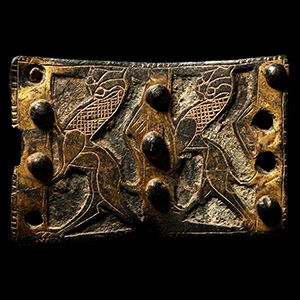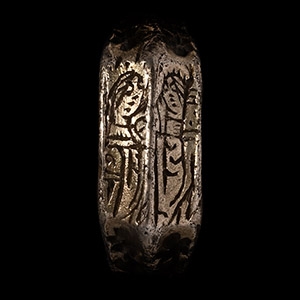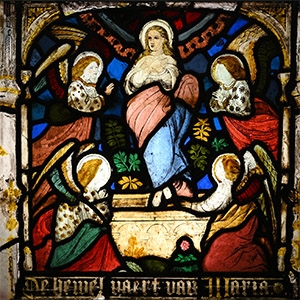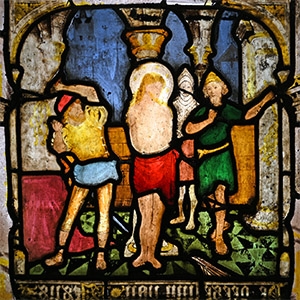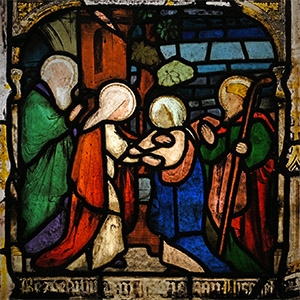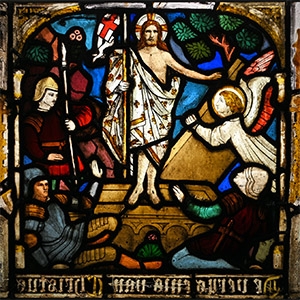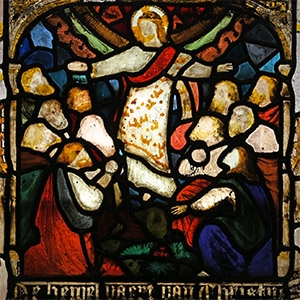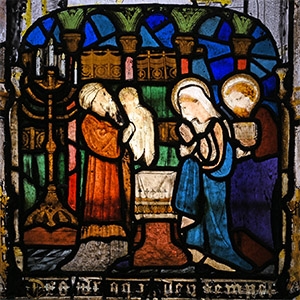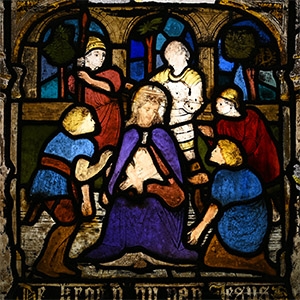Home > Auctions > 3 - 11 June 2025
Ancient Art, Antiquities, Books, Natural History & Coins
From the private collection of Mrs T Hedwig; thence by descent, 2000s.
Accompanied by a copy of a Belgian export licence no.006952, Brussels.
This lot is accompanied by an illustrated lot declaration signed by the Head of the Antiquities Department, Dr Raffaele D'Amato.
Acquired 1990 with inventory no.90.91 and cat.582.
From an important London, UK, collection, in the late 1990s.
Property of a South West London academic since circa 2010.
Accompanied by an academic report by heraldry specialist Dr Paul A. Fox, FSA.
This lot is accompanied by an illustrated lot declaration signed by the Head of the Antiquities Department, Dr Raffaele D'Amato.
See Paul A Fox, A Medieval Enamel Belt os Strap Fitting and its Possible Connection with the Arms of King Henry II in Antiquaries Journal 2019.
Fox, Paul A., A Medieval Enamel Belt or Strap Fitting and its Possible Connection with the Arms of King Henry II, The Antiquaries Journal of the Society of Antiquaries of London, 99, 2019, pp.95-103.
Ex Thomas collection, UK, 1960s-1980s.
Property of a Cambrigeshire, UK, gentleman.
This lot is accompanied by an illustrated lot declaration signed by the Head of the Antiquities Department, Dr Raffaele D'Amato.
Cf. Chadour, A.B., Rings. The Alice and Louis Koch Collection, volume I, Leeds, 1994, item 587, for type.
From a war-damaged church in Belgium.
Ex property of a late Northumberland collector.
From a private collection, Derbyshire, UK.
This lot is accompanied by an illustrated lot declaration signed by the Head of the Antiquities Department, Dr Raffaele D'Amato.
Cf. similar scene in the Metropolitan Museum of Art, New York, accession no.41.190.457, Assumption of the Virgin, stained glass from Jan Rombouts, circa 1505, in The Metropolitan Museum of Art, Bulletin 1971-January 1972, New York, 1972, p.52.
The Assumption of Mary into Heaven is a dogma of faith of the Roman Catholic Church, according to which Mary at the end of her earthly life went to Heaven in body and soul. According to the Eastern Orthodox tradition, the Assumption of Mary was preceded by a deep sleep (Dormitio Virginis): but the Dormition of Mary is not the object of dogma, while her glorification in body and soul is an integral part of the faith of the Catholic Church.
From a war-damaged church in Belgium.
Ex property of a late Northumberland collector.
From a private collection, Derbyshire, UK.
This lot is accompanied by an illustrated lot declaration signed by the Head of the Antiquities Department, Dr Raffaele D'Amato.
Cf. similar image in the Victoria and Albert Museum, Flagellation of Christ from a book of Hours, Manuscript, Flanders, c.1470, accession no. 474032.
From a war-damaged church in Belgium.
Ex property of a late Northumberland collector.
From a private collection, Derbyshire, UK.
This lot is accompanied by an illustrated lot declaration signed by the Head of the Antiquities Department, Dr Raffaele D'Amato.
Cf. similar scenes in McNamara, In relation to sixteenth century Italian Visitation paintings, how far could Elizabeth, mother of John the Baptist, be considered as the forerunner of the Virgin Mary? London, 2015, figs.5-6-7-8.
The scene commemorates Mary's visit to her cousin Elizabeth after receiving the announcement that she would become the mother of Jesus (Luke, I, 39-45). In this guise, Mary is called Our Lady of the Visitation or Mary Most Holy of the Visitation.
From a war-damaged church in Belgium.
Ex property of a late Northumberland collector.
From a private collection, Derbyshire, UK.
This lot has been cleared against the Art Loss Register database, and is accompanied by an illustrated lot declaration signed by the Head of the Antiquities Department, Dr Raffaele D'Amato.
Cf. similar scene in ‘Resurrection of Christ’, historiated initial R from a Gradual, ms. Ludwig VI 3 (83.MH.86), f.16r, late 15th or early 16th century, The J. Paul Getty Museum, Los Angeles.
The scene represents the Resurrection of Christ according to the Gospel of Matthew (28,2-4), as revealed by the presence of an angel moving away the stone, and of the soldiers. According to the Christian tradition, the bodily resurrection was the restoration to life of a body transformed and nourished by the spirit, as described by Paul and the Evangelists, which led to the affirmation of Christianity. In Christian theology, the Resurrection of Jesus is ‘the fundamental mystery of faith’, as recalled by Easter, together with the remaining Christological mystery (Incarnation, Passion and Death), and together with the Logia and the works of the ministry of Jesus. For Christians, the resurrection of Jesus is a guarantee that all the dead Christians will come back to life at the time of the parousia (second coming) of Christ.
From a war-damaged church in Belgium.
Ex property of a late Northumberland collector.
From a private collection, Derbyshire, UK.
This lot is accompanied by an illustrated lot declaration signed by the Head of the Antiquities Department, Dr Raffaele D'Amato.
Cf. similar image in the Victoria and Albert Museum, Nativity, accession no.C.301.1928.
The scene represents the nativity according to the Gospel of Luke (2:1-21). Luke, unlike Matthew, mentions the shepherds and the birth of Jesus inside a manger because there was no space in the katalyma (private house).
From a war-damaged church in Belgium.
Ex property of a late Northumberland collector.
From a private collection, Derbyshire, UK.
This lot is accompanied by an illustrated lot declaration signed by the Head of the Antiquities Department, Dr Raffaele D'Amato.
Cf. similar scene in the Metropolitan Museum of Art, New York, The Ascension of Christ of Von Klumbach, circa 1513 A.D., accession no.21.84, in The Metropolitan Museum, Gothic and Renaissance Art in Nuremberg, 1300-1550, New York, 1986, p.349, no.66b.
The scene represents the Ascension of Christ, described in Luke 24,1 and Acts 1,1-9. The Ascension is the last episode of Jesus' earthly presence according to the two narratives. It describes his definitive ascension to heaven, from which he will return only at the end of time (Parousia).
From a war-damaged church in Belgium.
Ex property of a late Northumberland collector.
From a private collection, Derbyshire, UK.
This lot is accompanied by an illustrated lot declaration signed by the Head of the Antiquities Department, Dr Raffaele D'Amato.
Cf. similar structure of ‘The Annunciation’, work of Simon Bening, Fiammingo, early 16th century A.D., Paul Getty Museum, inv.no.83.ML.115.13v.
The scene represents the announcement made by the angel Gabriel to Mary, that she would conceive and bear a son through the Holy Spirit (according to the Gospel of Luke, I, 26-38). In some regional contexts it is called Conceptio Domini or Conceptio Christi.
From a war-damaged church in Belgium.
Ex property of a late Northumberland collector.
From a private collection, Derbyshire, UK.
This lot is accompanied by an illustrated lot declaration signed by the Head of the Antiquities Department, Dr Raffaele D'Amato.
Cf. similar scene in The Presentation at the Temple (c. 1506-11), by Grão Vasco, part of the polyptych of the High Chapel of the Lamego Cathedral, published in Braga A. and Brás P., A Sé de Lamego no Museu, catálogo de exposição, ed. SEC e Museu de Lamego, Museu Diocesano de Lamego, Lamego, 2014.
The Gospel of Luke (II,22-39) narrates that Mary and Joseph took baby Jesus to the Temple in Jerusalem forty days after his birth, to ‘offer him’ to God. All first-born male children went through this ceremony in compliance with the command of the Exodus. During their visit, they met Simeon, who had been told that he would not die before seeing the Messiah. Simeon praised the Lord with the words that are now known as the Song of Simeon.
From a war-damaged church in Belgium.
Ex property of a late Northumberland collector.
From a private collection, Derbyshire, UK.
This lot is accompanied by an illustrated lot declaration signed by the Head of the Antiquities Department, Dr Raffaele D'Amato.
Cf. similar image in the Metropolitan Museum of Art, New York, accession no.41.190.454, stained glass by Jan Rombouts, early 16th century AD.
The scene represents the ‘Mocking of Christ’ from the Gospel of Matthew (27,27.31): ‘Then the governor’s soldiers took Jesus into the Praetorium and gathered the whole company of soldiers around him. They stripped him and put a scarlet robe on him, and then twisted together a crown of thorns and set it on his head. They put a staff in his right hand. Then they knelt in front of him and mocked him. “Hail, king of the Jews!” they said’.
217 - 228 of 3130 LOTS


